Silence (43) - Tĩnh lặng (43). Mai Văn Phấn. Explicated by Dr. Ramesh Chandra Mukhopadhyaya - chú giải. Traduction française Dominique de Miscault – Dịch sang tiếng Pháp. Takya Đỗ dịch sang tiếng Việt
14/10/2017
SILENCE
Poems by MAI VĂN PHẤN
Translated into English by NHAT-LANG LE
English Translator-Poet SUSAN BLANSHARD
Translated into French by DOMINIQUE DE MISCAULT
Explications by RAMESH CHANDRA MUKHOPADHYAYA
(based on English translation of the poems)
Edited by SUSAN BLANSHARD
Translated into French and Illustrated by DOMINIQUE DE MISCAULT
Translated into Vietnamese by
PHẠM MINH ĐĂNG (1 ~ 19) & TAKYA ĐỖ (20 ~ 45 and Preface)

Tác phẩm của Nhà thơ - Họa sỹ Dominique de Miscault chọn cho bài thứ 43
43
I sit down
And drop flowers on water
Releasing them
On a surface vast
And clear
Bells
Ring through my body
Into the depth of water
Dong!
I sink
Then emerge again.
(Translated from Vietnamese by Nhat-Lang Le & Susan Blanshard)
Explication
In the earlier section, the
poet meditated on the stream of life in the mountain that flows steadily into a
lake without making a noise. And when the poet sees into the transparent lake,
a stream of light surrounds the poet. And when a stream of light surrounds the
poet it is kinesthetic imagery which pertains to a sense of bodily motion. In
other words, the poet feels that his whole body, including emotions and senses,
is a movement. The poet’s body is transformed at the foot of the altar
tower. Earlier we saw a stream in a moment falling in a transparent lake
without any sound. The lake seems to reflect the course of the stream or the
flow of life at the foot of altar tower. Maybe we have come down from the
mountain, and when we reach death, we understand it is the foot of an altar
indescribable sublime and life is a continuous prayer. Once we reach the lake
at the bottom, we become aware of the altar tower, and at once the life which
is apparently full of sorrow becomes a stream of light flowing down from the
indescribable inscrutable infinitude which can be only understood when we see
into death. And we begin to worship life seated at the feet of the altar tower.
Life is an altar tower that could take us to the unnamable, giving our
mind the challenge to go back in time and space, so defying the laws of
thermodynamics. Once we go back in time and space, we meet our father grandmother
and mother. Each of them teaches us how to forget. Keats sought to forget the
fever and fret of life. First, he thought alcohol might help him escape from
the groans of existence. Later, Keats felt that he could accompany the
nightingale which had never known the leafy world that we know, in the mundane
world of ours. So he follows the bird on the viewless wings of poesy and fades
into the dim forest far off from the sphere of sorrow. But after a time the
word forlorn flashes upon his mind and it shatters the poet’s reverie. Thus
neither alcohol nor fancy can transport us from the groans of existence. One
must see life as a whole at the point of death and learn that a rebirth could
be there. Vibrant with a fresh lease of life if one could go against time and
the laws of thermodynamics one would meet one’s forefathers. Whatever Mai Văn
Phấn writes, he writes from experience. His father suffered from
Alzheimer’s disease before he died. But the poet meets him now that he sees
life steadily and as a whole. He finds his father sans any physical ailment.
The poet meeting his father reminds one of Aeneas meeting his father in Virgil.
In fact meeting one’s dead fathers is a recurrent motif in heroic poetry, and
this is also a fragment of heroic poetry as it were. Here the poet meets his
father and mother and grandfather. Our minds and senses are always drawn
outward to the world of delusion. The hero of the poet Mai Văn Phấn forces them
to look inward and thereby to go against the flow, a tide of time through
meditation. According to Buddhist cosmology, there are thirty-one planes of
existence. Among them, six planes of life belong to kama loka. The human realm is only one of
them. So our parents may have left the human realm. But ordinarily, they very
much exist in some other realm, may be of the kama loka. And the poet meets his
deceased ancestors in other planes of kama loka. And lo! Father does not suffer
from Alzheimer’s disease any longer, and the grandmother no longer stoops. How
could this be possible? The theory of
Dependent Origination posits that whatever takes place in the existence is
dependent on numerous causes and conditions and hence whatever takes place in
the existence has no essence. Therefore, the very sight of the deceased persons
of father and grandmother free from physical ailments teaches the poet that
nothing in existence has any essence. They teach the poet how could they forget
the sufferings of the world. Once we know that the world in which we suffer and
the sufferings that we experience in the world have no essence and once we know
that they are mere delusions we can get rid of them. This knowledge makes the
poet transparent bereft of the crudities of worldly existence. He transcends
the kama loka too and exclaims:
As I leave
holding in my hand
a flower.
The flower is a lotus. Although the poet is born in the world and
grown in the world, he is no longer soiled by the world.
SILENCE
Poèmes de MAI VĂN PHẤN
Traduits en Anglais par NHAT-LANG LE
Edités par SUSAN BLANSHARD
Traduits en Français par DOMINIQUE DE MISCAULT
Interprétés en Anglais par
RAMESH CHANDRA MUKHOPADHYAYA
(interprétation basée sur la traduction en anglais des poèmes)
Edités par SUSAN BLANSHARD
Traduite en français et illustrée par DOMINIQUE DE MISCAULT
Traduite en Vietnamien par
PHẠM MINH ĐĂNG (1 ~ 19) & TAKYA ĐỖ (20 ~ 45 et Préface)
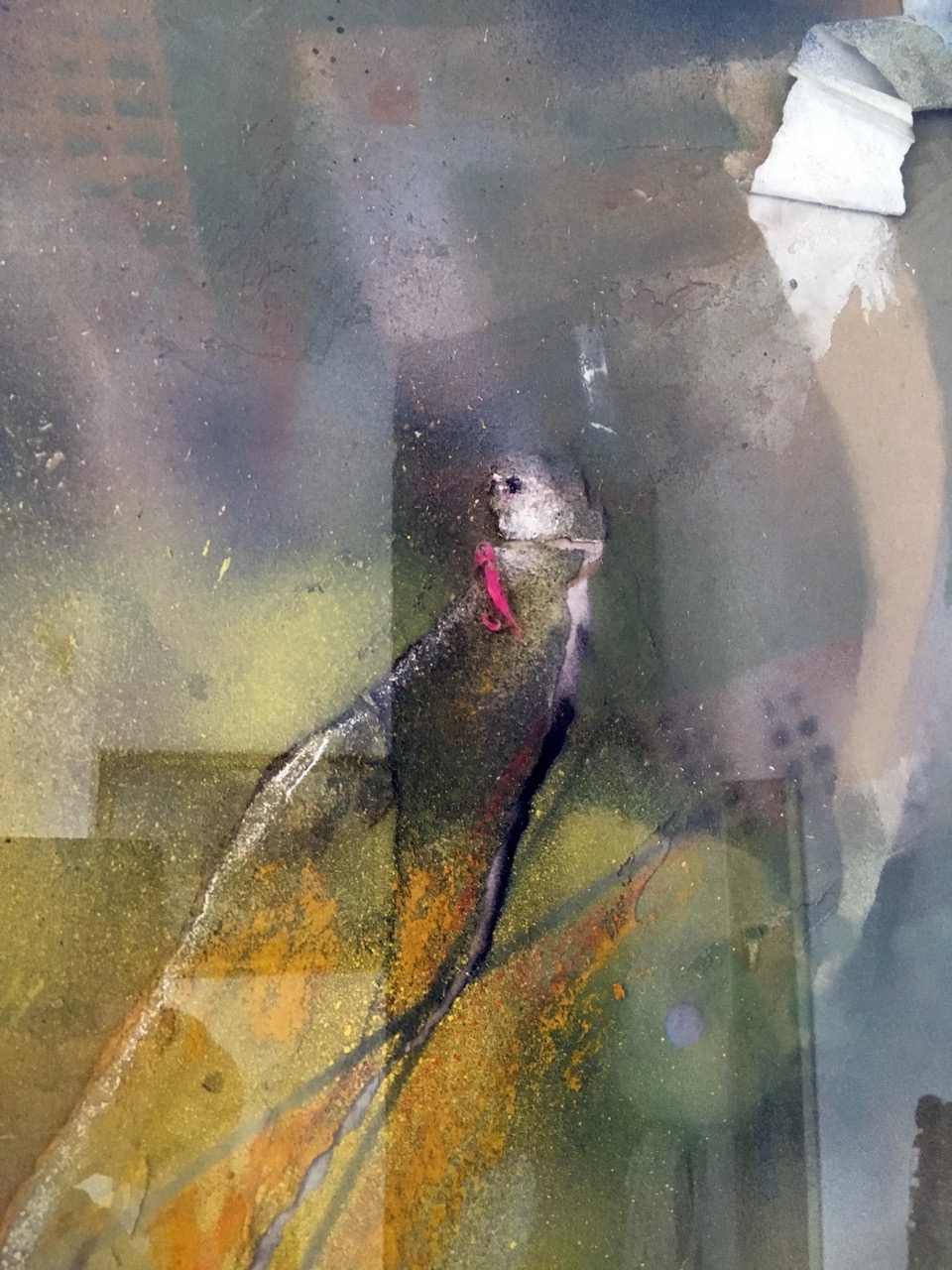
Tác phẩm của Nghệ sỹ Dominique de Miscault
43
Assis
je jette des fleurs sur l'eau
Libérées
sur la large surface
claire
Des carillons
sonnent de mon corps
jusqu’aux profondeurs des eaux
Dong !
je coule
puis émerge à nouveau.
Explication
Assis le poète jette des
fleurs sur l'eau. Les hommes ont toujours vénéré les eaux. Pour prier, nous
offrons des fleurs à la déesse de l'eau. En Inde, on respecte les étangs, les
lacs, les rivières et l'océan. Pourquoi offrir des fleurs à une divinité ?
Parce que les fleurs sont aussi le symbole du soleil ou de la lune. Elles sont
douces sous le soleil, rayonnantes de lumière et de parfum. Ce n'est pas tout,
une fleur est une mine de sagesse pour l'homme à la perception juste.
Rappelons-nous du Bouddha qui tient une fleur au lieu de prononcer un sermon.
Mahakashyapa
seul comprit le message et sourit au milieu de toute une foule de dévots qui ne
pouvaient pas comprendre son silence. Le recueil Silence de Mai Văn Phấn est un triomphe
de poésie. Bien qu'apparemment chaque poème soit tout simple et aussi beau
qu'une fleur, peu, très peu, peuvent décoder leur fond à travers les ruptures
des images. Silence appartient à
l'école de l’imaginaire. Pour Elliot,
la poésie est le transport des émotions personnelles dans un monde de l'art
impersonnel. Ici, Mai Văn Phấn nous offre sa spiritualité dans un monde
impersonnel. Chaque poème est donc aussi impersonnel et objectif que les objets
naturels. Picasso prétendait que le Cubisme
n'imitait plus la nature : Il créait de nouveaux objets introuvables dans
la nature. Dominique De Miscault pourrait sans doute nous éclairer. Et
peut-être Mai Văn Phấn à travers son recueil Silence a apporté des fleurs des hauteurs Empyrées ou des jardins
japonais. Désolé pour la digression. Mais tout lecteur doit se concentrer sur
chaque image de Mai Văn Phấn et méditer pour comprendre sa portée. Mai Văn Phấn
est assis et jette des fleurs sur l'eau. Mais nous vous assurons qu'il ne
laisse pas tomber de fleurs dans une rivière ou un étang, mais au contraire il
les libère. Les eaux ici sont donc une mer ou un océan, quelque chose de bien
plus grand encore. Mai Văn Phấn est l'un de ces poètes qui ressent et réalise
que le monde intérieur ne correspond en rien au monde extérieur. Sans doute
offre-t-il les fleurs de sa poésie à la vaste étendue des eaux qui sont l'un
des cinq éléments - la terre, l'eau, le feu, l'air et l'éther ou les cinq
cailloux qui constituent l'existence. Offrir des fleurs aux eaux extérieures,
c’est offrir des fleurs aux eaux intérieures de son corps. Soixante-cinq pour
cent du corps humain est composé d'eau. Quand nous prenons soin de notre corps,
nous vénérons l'eau en nous. Chaque action dans notre existence est un culte. Mais
ce n'est pas tout. La vaste surface d'eau claire pourrait être comparée à la
conscience cosmique ou à l'esprit de Bouddha. Si le poète n’avait pas offert
des fleurs à la mer ou à l’océan, il n'y aurait pas eu de carillon en lui. On
pourrait donc soutenir que les fleurs des sens, les plaisirs ont été offerts
par le poète à la conscience sans limites ou à l'esprit de Bouddha en lui. Les
neurones dans le corps du poète dansent et chantent, sautent du plaisir de
s’offrir au non-moi cosmique. Aucune langue ne peut décrire cette situation.
Seul le verbe primordial s’exprime au
fond du corps du poète. C'est un signifiant dont le signifié est infini :
silence avant lui, langue d’avant lui. Le son de la cloche invite le poète dans
le bleu profond de la béatitude et des bénédictions. Le poète dit : Dong !
Je coule
et émerge à nouveau
Il n'y
a pas de meilleur poème décrivant la fusion de la conscience individuelle et de
la conscience cosmique.
Mahakashyapa est l’un des plus importants disciples du
Bouddha, Shakyamuni, réputé le meilleur pour l’observation des règles dans les
détails ou ascétiques et gardien de l’ordre de la Communauté en l’absence du
bouddha Gautama et après sa mort. C’est lui qui aurait convoqué et présidé le premier
concile. Il est considéré comme le premier patriarche du Chan/Zen. En Chine, il
est connu sous le nom de Mohejiashe, grand Kāśyapa, son nom au Japon est
Makakaso. Dans les monastères bouddhiques, d'une façon générale, les statues de
Mahā Kāśyapa et d'Ananda debout se trouvent aux côtés de la statue du Bouddha
Shakyamuni assis. Divers historiens actuels, parmi de nombreuses chronologies,
datent les événements : -563 le Bouddha naît, -483 à la mort du Bouddha
Mahakashyapa devient le chef de la Communauté bouddhique, -482 il organise le
premier concile bouddhique.
TĨNH LẶNG
MAI VĂN PHẤN
Bản dịch thơ tiếng Anh: LÊ ĐÌNH NHẤT-LANG
Biên tập bản dịch thơ tiếng Anh: SUSAN BLANSHARD
Bản dịch thơ tiếng Pháp: DOMINIQUE DE MISCAULT
Bình chú: RAMESH CHANDRA MUKHOPADHYAYA
(dựa trên bản dịch thơ tiếng Anh)
Biên tập bình chú tiếng Anh: SUSAN BLANSHARD
Dịch bình chú ra tiếng Pháp và minh họa:
DOMINIQUE DE MISCAULT
Dịch bình chú ra tiếng Việt:
PHẠM MINH ĐĂNG (1 ~ 19) & TAKYA ĐỖ (20 ~ 45 & Lời tựa)
43
Tôi ngồi
Thả bông hoa trên nước
Buông
Trên mặt phẳng rộng
Và trong
Tiếng chuông
Qua thân thể tôi
Vào đáy nước
Boong!
Tôi chìm
Lại
nổi lên.
Bình chú:
Trong phần
trước, nhà thơ quán tưởng về dòng suối cuộc đời từ núi đổ bình lặng xuống hồ
không gây tiếng động. Và khi nhìn vào mặt hồ trong suốt, một dòng ánh sáng phủ
tràn nhà thơ. Dòng suối hàm ý dòng chảy. Và khi một dòng ánh sáng phủ tràn nhà
thơ, đó là một hình ảnh chuyển động gắn liền với
cảm giác chuyển động cơ thể. Nói cách khác, nhà thơ cảm thấy toàn bộ cơ
thể mình bao gồm cảm xúc và ý thức là một lối chuyển động. Cơ thể nhà thơ được
chuyển hóa dưới chân tháp. Trước đó ta thấy dòng suối trong khoảnh khắc chảy
vào lòng hồ trong suốt không một tiếng động. Lòng hồ đó như thể phản chiếu lộ
trình dòng suối hoặc dòng chảy cuộc đời là về chân ngọn tháp. Có thể ta từ ngọn
núi đi xuống và khi tiến dần cái chết, ta hiểu rằng cái chết là chân ngọn tháp
hùng vĩ ngợp lời và cuộc sống là một lời nguyện cầu không dứt. Khi tiến đến đáy
hồ, ta thức tỉnh về ngọn tháp và ngay lúc đó, cuộc sống vốn dĩ tràn ngập nỗi
buồn trở thành dòng ánh sáng chảy xuống từ cõi vô hạn bí hiểm khôn cùng và bất
khả diễn giải, chỉ có thể cảm thức khi ta nhìn thấu cái chết. Và ta bắt đầu thờ
phụng cuộc sống khi ngồi dưới chân ngọn tháp. Cuộc sống là một tháp thiêng hoặc
một khám thờ đưa ta về cõi không thể gọi tên. Điều này đưa tâm trí
ta vào một thách thức ngược trở lại thời gian và không gian, cưỡng lại các định
luật nhiệt động lực học. Khi ngược trở lại thời gian và không gian, ta gặp lại
ông bà cha mẹ. Họ dạy ta cách quên. Nhà thơ John Keats tìm cách quên lãng những
cơn sốt và nỗi ưu phiền cuộc sống. Ban đầu ông nghĩ rượu có thể kéo ông thoát
khỏi nỗi bi thương sinh tồn. Rồi sau ông cảm thấy mình có thể đồng hành cùng
loài chim sơn ca ẩn mình trong thế giới xanh lá của chúng, chúng chẳng bao giờ
biết đến những gì ta biết trong thế giới trần tục của mình. Bởi vậy ông dõi
theo loài chim đó trên đôi cánh hút tầm mắt của thơ ca và mờ dần vào rừng xa
mịt mùng lánh xa cõi thế muộn phiền. Nhưng theo thời gian, chính từ cô quạnh chập chờn trong tâm trí ông và
đập tan những ảo tưởng của nhà thơ. Cả rượu lẫn huyễn tưởng không thể kéo ta
khỏi nỗi bi thương của sinh tồn. Con người cần nhìn nhận đời sống như một khối
nhất thể từ điểm chết và nhận ra sự tái sinh có thể ở đó. Sôi động với sức sống
mới tràn đầy, khi một người có thể chống lại thời gian và các định luật nhiệt động lực học, người ấy sẽ gặp được
tổ tiên của mình.
Những gì Mai
Văn Phấn viết đều khởi nguồn từ kinh nghiệm. Cha ông mắc chứng Alzheimer và đã
mất. Nhưng nhà thơ đã gặp cha mình lúc này, ông thấy cuộc sống vẫn không thay
đổi và là nhất thể. Ông thấy cha mình không còn bệnh nữa. Cuộc gặp giữa nhà thơ
với cha gợi nhớ tới cuộc gặp giữa Aeneas và cha trong thơ của Virgil.
Trên thực tế, gặp gỡ người cha đã mất là chủ đề quen thuộc trong các hùng ca.
Và có thể nói đây cũng là một phần của hùng ca. Nơi đây nhà thơ gặp cha mẹ và
ông mình. Tâm trí và giác quan của chúng ta luôn bị kéo hướng tới thế giới ảo
giác. Người anh hùng của nhà thơ Mai Văn Phấn buộc chúng phải nhìn vào trong và
bằng cách đó chống lại ngọn thủy triều của thời gian nhờ thiền định. Theo vũ trụ học Phật giáo, có ba mươi mốt cõi. Trong
đó có sáu cõi Dục Giới. Cõi
người chỉ là một trong số đó. Cha mẹ chúng ta có thể đã rời cõi người. Nhưng
thường họ nương ở một cõi nào đó khác, có thể là Dục Giới. Và nhà thơ gặp lại
tổ tiên của mình trong các cõi khác của Dục Giới. Và kìa! Cha đã thôi bị cơn
bệnh run tay hành hạ và bà nội không còn còng lưng nữa. Điều này có thể ư?
Thuyết Duyên Khởi
cho rằng hiện tồn phụ thuộc vào vô số nguyên nhân và điều kiện nên tất cả những
gì xảy ra trong hiện tồn không có thật chất. Vì vậy việc nhìn thấy những người
đã khuất, thấy cha và bà nội đã thoát khỏi bệnh tật thể chất thức tỉnh nhà thơ
rằng không có gì tồn hiện mà có thật chất. Họ cho nhà thơ biết cách họ đã quên
các nỗi khổ đau trần thế. Một khi ta hiểu rằng thế giới nơi ta đang chịu dày vò
và những chịu đựng ta trải nghiệm ở đây là không thật chất, một khi ta hiểu
rằng đó chỉ là những ảo ảnh thuần tuý, ta có thể dứt bỏ. Nhận thức này khiến
nhà thơ trong suốt bước ra khỏi tồn tại khổ đau. Ông vượt thoát cõi Dục Giới và
thốt lên
Tôi trong suốt
Ra đi
Trong tay cầm một bông hoa.
Bông
hoa ở đây là hoa sen. Mặc dù nhà thơ sinh ra và lớn lên trong thế giới
này, nhưng ông đã không còn chịu sự ràng buộc của những bụi bặm thế gian.
________________
[1] John
Keats (1795-1821) là nhà thơ lãng mạn của Anh. Ông là một trong những nhà thơ
lãng mạn lớn ở thế hệ thứ hai của Anh, cùng với Lord Byron và Percy Bysshe
Shelle. (BT)
[2] Tức
Publius Vergilius Maro (năm 70-19 trước CN), thi hào La Mã thời Augustus trị vì
(năm 27 trước CN-năm 14 sau CN), thời kỳ được gọi là thời đại hoàng kim của văn
chương La Mã cổ đại. Aeneas – nhân vật chính trong sử thi Aeneid, một trong các
tác phẩm nổi tiếng của ông và của nền văn chương La Mã cổ đại – là một người ở
thành Troy chu du sang Ý và trở thành tổ tiên của người La Mã. Trong sử thi này
có đoạn Aeneas được đưa lên thiên đàng nơi ông gặp và nói chuyện với linh hồn
cha mình và được cho thấy một ảo cảnh tiên tri về số phận của La Mã. (Theo
Wikipedia tiêng Anh) (BT)
[3] Xem chú thích ở bài 1. (BT)
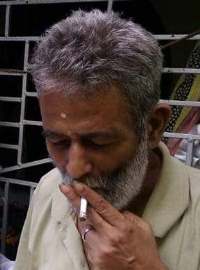
Dr. Ramesh Chandra Mukhopadhyaya
Date of Birth: 11/02/1947. Education M.A [triple] M Phil Ph DSutrapitaka tirtha plus degree in homeopathy. He remains a retired teacher of B.B. College, Asansol, India. He has published books in different academic fields including religion, sociology, literature, economics, politics and so on. Most of his books have been written in vernacular i.e. Bengali. His maternal grand grand father MM Haraprasad Shastri and his maternal grandfather Dr Benoytosh Bhattacharyya ex Director Oriental Research Institute, were great scholars in the field of Buddhism in the modern Indian context. He was awarded a gold medal by the University of Calcutta for studies in modern Bengali drama. He has a niche as a recognized critic of Indo Anglian Literature. His studies on K.V. Dominic as a poet published from the U.S.A and his study of Mai Văn Phấn’s “hidden face flower” has been appreciated by the readers of poetry in different countries of the world.
TS. Ramesh Chandra Mukhopadhyaya
Ngày sinh: 11/02/1947. Ông có ba bằng thạc sĩ (ngành tiếng Anh cổ điển, tiếng Anh hiện đại và Lịch sử hiện đại), bằng thạc sĩ ngành Văn học so sánh, bằng tiến sĩ ngành Văn học kinh điển Pali, cùng với Bằng y học về phép chữa vi lượng đồng căn. Ông còn là một giảng viên đã nghỉ hưu của Trường đại học B.B, Asansol, Ấn Độ. Ông đã có những cuốn sách được xuất bản về nhiều lĩnh vực học thuật bao gồm tôn giáo, xã hội học, văn học, kinh tế, chính trị v.v. Hầu hết sách của ông đã được viết bằng tiếng bản địa là tiếng Bengali. Cụ ngoại của ông - ngài học giả danh dự Haraprasad Shastri, và ông ngoại của ông - Tiến sỹ Benoytosh Bhattacharyya là cựu Giám đốc Học viện Nghiên cứu Phương đông, là những học giả nổi tiếng trong lĩnh vực Phật giáo ở bối cảnh Ấn Độ hiện đại. Tiến sỹ Ramesh đã được tặng thưởng huy chương vàng của Trường đại học Calcutta về các nghiên cứu nghệ thuật sân khấu Bengal hiện đại. Ông có vị thế đặc biệt của một nhà phê bình uy tín trong lĩnh vực văn học Ấn độ viết bằng tiếng Anh. Các nghiên cứu của ông về K.V. Dominic - một nhà thơ từng được xuất bản tại Hoa Kỳ, và nghiên cứu về tập thơ "hoa giấu mặt" của Mai Văn Phấn được các độc giả thơ ca tại các quốc gia khác nhau trên thế giới đánh giá cao.
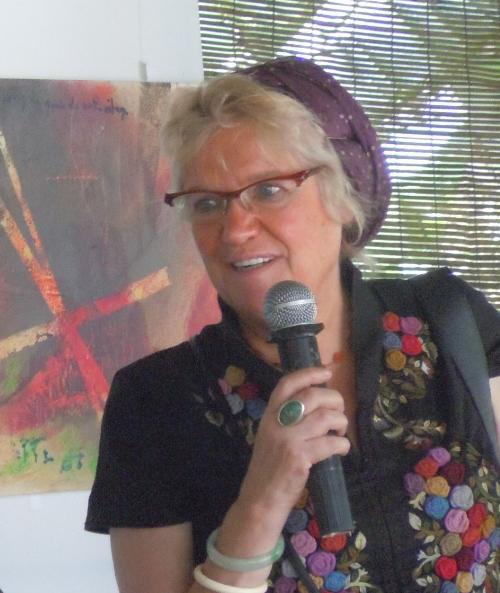
Nhà thơ - Nghệ sỹ Dominique de Miscault
Poétesse - Artiste Dominique de Miscault
Artiste Plasticienne. Actualités. De plages en pages qui se tournent. C’était hier, de 1967 à 1980, mais aussi avant hier. puis de 1981 à 1992. Et encore de 1992 à 2012 bien au delà des frontières. Aujourd’hui, la plage est blanche sous le bleu du soleil. Ecrire en images, cacher les mots porteurs de souffrance ; on ne raconte pas les pas d’une vie qui commence en 1947. C’est en 1969 que j’ai été invitée à exposer pour la première fois. Depuis j’ai eu l’occasion de « vagabonder » seule ou en groupe en France et dans le monde sûrement près de 300 fois. Les matériaux légers sont mes supports, ceux du voyage et de l’oubli.
www.dominiquedemiscault.fr
www.dominiquedemiscault.com
www.aleksander-lobanov.com
Nhà thơ - Nghệ sỹ Dominique de Miscault
Nghệ sĩ nghệ thuật thị giác đương đại. Từ bãi biển đến trang giấy. Là ngày hôm qua, từ 1967 đến 1980, và trước đó, rồi từ 1981 đến 1992. Và nữa từ 1992 đến 2012 trên tất cả các biên giới. Ngày hôm nay là bãi biển trắng dưới bầu trời xanh. Viết bằng hình ảnh, giấu từ ngữ mang nỗi đau, người ta không kể lại những bước đi trong cuộc đời tính từ năm 1947. Vào năm 1969, lần đầu tiên tôi được mời triển lãm tác phẩm. Kể từ đó, tôi có cơ hội một mình "lang bạt" hoặc theo nhóm ở nước Pháp và khắp nơi trên thế giới, chắc chắn gần 300 lần. Những chất liệu nhẹ là nguồn hỗ trợ tôi, những chất liệu của hành trình và quên lãng.
www.dominiquedemiscault.fr
www.dominiquedemiscault.com
www.aleksander-lobanov.com
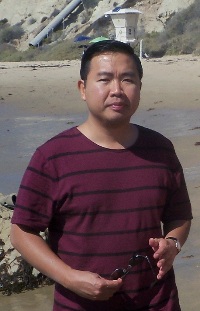
Nhà thơ – Dịch giả Lê Ðình Nhất-Lang
Poet – Translator Nhat-Lang Le
Nhat-Lang Le (Lê Đình Nhất-Lang) was born in 1969 in Saigon, emigrated with his family to France in 1983, and moved to the U.S. in 1985. He has a B.A. in Linguistics and Computer Science from the University of California, Los Angeles (UCLA). Nhat-Lang Le worked for more than a decade as a software programmer, before switching careers to work as a news translator and editor for a Vietnamese media organization based in the Little Saigon area of Southern California. He is a co-author of Poems of Nguyễn Thúy Hằng, Đỗ Lê Anhdao & Lê Đình Nhất-Lang (Vagabond Press, 2017). He is the translator of two of Mai Văn Phấn’s collections Seeds of Night and Day (Page Addie Press, 2013) and Grass Cutting in a Temple Garden (Page Addie Press, 2014). He is a co-translator of Poems of Lưu Diệu Vân, Lưu Mêlan & Nhã Thuyên (Vagabond Press, 2014) and The Selected Poems of Mai Văn Phấn (Publishing House of the Vietnam Writers’ Association, 2015). His Vietnamese poems and translations have appeared in the printedmagazines Thế Kỷ 21, Văn Học and Văn, and the literary e-zines Tiền Vệ (tienve.org) and Da Màu (damau.org). He has been on Da Mau’s editorial staff since 2007.
Nhà thơ – Dịch giả Lê Ðình Nhất-Lang
Lê Ðình Nhất-Lang (Nhat-Lang Le) sinh năm 1969 tại Sài Gòn, theo gia đình sang Pháp năm 1983, sang Hoa Kỳ năm 1985. Có bằng cử nhân ngành Ngữ học và khoa học điện toán tại Ðại học California, Los Angeles (UCLA). Từng làm lập trình viên nhiều năm, trước khi chuyển sang dịch thuật và biên tập tin tức cho một cơ quan truyền thông Việt ngữ ở vùng Little Saigon, Nam California. Đồng tác giả tuyển tập Poems of Nguyễn Thúy Hằng, Đỗ Lê Anhdao & Lê Đình Nhất-Lang (Nxb. Vagabond Press, 2017). Dịch giả Anh ngữ của hai tập thơ Mai Văn Phấn, Seeds of Night and Day - Những hạt giống của đêm và ngày (Page Addie Press, 2013) và Grass Cutting in a Temple Garden – Ra vườn chùa xem cắt cỏ (Page Addie Press, 2014). Đồng dịch giả của tuyển tập Poems of Lưu Diệu Vân, Lưu Mêlan &Nhã Thuyên (Nxb. Vagabond Press, 2014) và The Selected Poems of Mai Văn Phấn (Nxb. Hội Nhà văn VN, 2015). Có thơ và dịch phẩm tiếng Việt đăng trên các tạp chí Thế Kỷ 21, Văn Học, Văn, các báo mạng Tiền Vệ (tienve.org), Da Màu (damau.org)… Trong ban biên tập tạp chí Da Màu từ năm 2007.
Nhà thơ – Biên tập viên Susan Blanshard
Poet – Essayist Susan Blanshard
Susan Blanshard was born in Hampshire, England. She is an internationally acclaimed poet, essayist, and best-selling author. Susan is English Translator-Poet for 8 award-winning bilingual poetry books. She is a Committee member of PEN International Women's Writers and a foundation member of Asian Pacific Writers and Translators. Susan has written more than 40 books: poetry, short stories, non fiction, fiction and poetic prose. Her works include Honey in My Blood, Fragments of the Human Heart and book-length poetic prose Sheetstone: Memoir for a Lover. Selected poetry and essays are published in literary magazines including PEN International Women Writers’ Magazine. The World’s Literary Magazine: Projected Letters, Six Bricks Press, Arabesque Magazine, Lotus International Women’s Magazine, Coldnoon International Journal of Travel andLiterature, Amaravati Poetic Prism 2017, ICORN International Cities of Refuge. Nuestra Voz/Our Voice/Notre Voix - The Anthology of the International PEN Women Writers’ Committee. Susan lived in Hanoi for eight years and has written four travel books on Vietnam. She is married to an Executive Creative Director and best-selling author. They have two adult children. Susan resides near Sydney, Australia where she is completing a co-authored novel with her husband.
Nhà thơ – Nhà phê bình VH Susan Blanshard
Susan Blanshard sinh ở Hampshire, Anh quốc. Bà là một nhà thơ, viết tiểu luận, là tác giả nằm trong danh sách có sách bán chạy nhất. Susan là thành viên của Hội Văn bút các nhà văn phụ nữ quốc tế, và là thành viên sáng lập của Hội Nhà văn và Dịch giả Châu Á Thái Bình Dương. Susan là nhà thơ, dịch giả tiếng Anh đã dịch tám thi tập ấn hành song ngữ đoạt giải thưởng. Susan đã viết hơn 40 cuốn sách gồm các thể loại: thơ, truyện ngắn, tiểu thuyết phi hư cấu, văn xuôi và thơ văn xuôi. Bà cũng từng xuất bản những tập văn xuôi mang đầy chất thơ như Sheetstone: Memoir for a Lover,Sleeping with the Artist, Fragments of the Human Heart, và Memoir of Love and Art: Honey in My Blood. Thơ và tiểu luận của bà đăng trên nhiều tạp chí và tuyển tập, như The World’s Literary Magazine, Projected Letters, Six Bricks Press, Arabesque Magazine, Lotus International Women’s Magazine, ICORN International Cities of Refuge. PEN International Women Writers’ Magazine. Tuyển tập của Hội Văn bút quốc tế The Fourth Anthology, Our Voice, Coldnoon International Journal of Travel and Literature, Tuyển tập thơ đa ngữ quốc tế Amaravati Poetic Prism 2017. Bà đã sống ở Hà Nội tám năm, đã viết bốn cuốn sách du lịch về Việt Nam. Bà kết hôn với một Giám đốc sáng tạo cấp cao đồng thời là một tác giả có sách bán chạy. Ông bà có hai người con đã trưởng thành. Susan sống gầnthành phố Sydney nước Úc, nơi bà đang hoàn thành cuốn tiểu thuyết sáng tác chung với chồng.
Tĩnh lặng - Silence (1)
Tĩnh lặng - Silence (2)
Tĩnh lặng - Silence (3)
Tĩnh lặng - Silence (4)
Tĩnh lặng - Silence (5)
Tĩnh lặng - Silence (6)
Tĩnh lặng - Silence (7)
Tĩnh lặng - Silence (8)
Tĩnh lặng - Silence (9)
Tĩnh lặng - Silence (10)
Tĩnh lặng - Silence (11)
Tĩnh lặng - Silence (12)
Tĩnh lặng - Silence (13)
Tĩnh lặng - Silence (14)
Tĩnh lặng - Silence (15)
Tĩnh lặng - Silence (16)
Tĩnh lặng - Silence (17)
Tĩnh lặng - Silence (18)
Tĩnh lặng - Silence (19)
Tĩnh lặng - Silence (20)
Tĩnh lặng - Silence (21)
Tĩnh lặng - Silence (22)
Tĩnh lặng - Silence (23)
Tĩnh lặng - Silence (24)
Tĩnh lặng - Silence (25)
Tĩnh lặng - Silence (26)
Tĩnh lặng - Silence (27)
Tĩnh lặng - Silence (28)
Tĩnh lặng - Silence (29)
Tĩnh lặng - Silence (30)
Tĩnh lặng - Silence (31)
Tĩnh lặng - Silence (32)
Tĩnh lặng - Silence (33)
Tĩnh lặng - Silence (34)
Tĩnh lặng - Silence (35)
Tĩnh lặng - Silence (36)
Tĩnh lặng - Silence (37)
Tĩnh lặng - Silence (38)
Tĩnh lặng - Silence (39)
Tĩnh lặng - Silence (40)
Tĩnh lặng - Silence (41)
Tĩnh lặng - Silence (42)
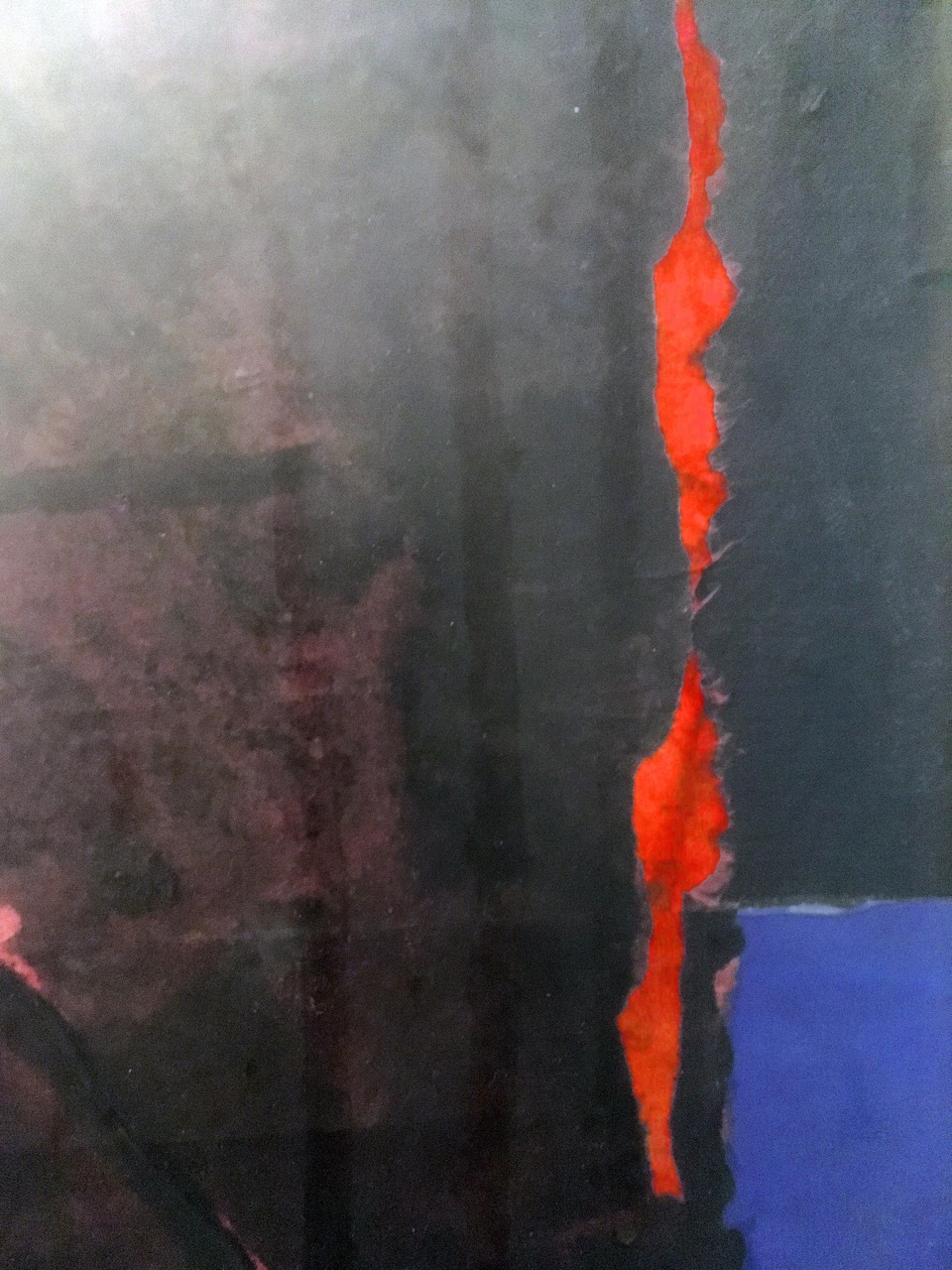
Tác phẩm của Nhà thơ - Họa sỹ Dominique de Miscault
|